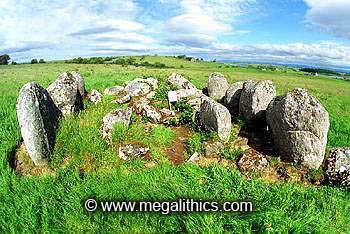
 |
|
Photo Gallery |
|
|
Panoramas |
|
| G 18392 33292 (GPS 30min). | |
| Visited June 2002 |
The Rathfranpark Wedge Tomb stands beside a
secondary road about 4km NW of Killala, the double Court Tomb of Carbad
More is just off the same road, about 1km to the south.
The site has fine views across the
Palmerstown River estuary to the Ox mountains of Sligo in the distance. The most impressive parts of the tomb remains are two rows of four massive
stones each at the north and south of the tomb, these are between 1.35 and 2m
tall. The large rows are almost certainly the outer sidewalls of the tomb, and
between them lie the two rows of smaller stones that make up the sidewalls of
the gallery itself. The gallery axis is ENE-WSW and only the western section of
the gallery is exposed, the eastern section being buried by a mound of large
stones, more of which later. Set just inside the gallery sidewalls at their
western extremity are two small stones that have been interpreted as entrance
jambs thus suggesting the entrance was situated at this end of the tomb.
We have to say that we are doubtful about the entrance being at the west end of
the gallery. The outer sidewalls diverge by over 1.5m towards the east of the
tomb, and in every other Mayo Wedge Tomb with well preserved sidewalls and
gallery, the entrance and facade are placed at the broad end of the tomb. Good
examples of this layout can be seen at the Carrowleagh, Carrowcrom
and Lisduff Wedge Tombs. Another problem with the western entrance idea is that
the stones of the southern sidewall extend 1.5m past the tiny gallery
"entrance jambs", if a facade were present this would make for a very
recessed entrance.
We were horrified to discover that the mound of large stones covering the east
end of the gallery was not debris from the Wedge Tomb, but was in fact the
remains of a destroyed stone circle. A stone circle once stood close to the tomb
until about 1951, over the rest of the fifties the circle stones were uprooted
and dumped onto the Wedge Tomb until all trace of the circle was removed.
We're pretty sure that you can guess how we feel about such a recent destruction
of the circle, and we just hope that the perpetrators of this noble deed
received the full attentions of the Wee Folk for their efforts. Unfortunately,
this is not the worst case we have heard of, as late as 1974 a unique stone circle in Co.
Fermanagh was completely destroyed. This circle had two tall stones closely
flanking a long low recumbent, a characteristic usually only found in the
Aberdeenshire recumbent circles of northeastern Scotland, and unique in Ireland.
Now
gone forever.